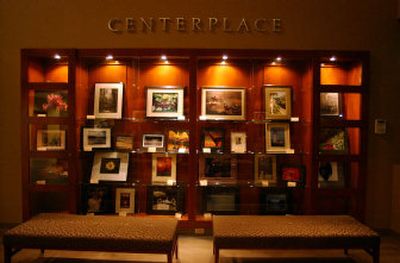Camera club work at CenterPlace

CenterPlace at Mirabeau is hosting a new exhibit through the month of February, highlighting members of the Spokane Valley Camera Club.
Valley resident and photographer Faris Harrison started the club in 1950 and it has been going strong ever since.
The club has about 70 members, ages ranging from the late 20s to late 80s. The show is a collection of 28 photographers displaying more than 50 photographs.
Larry Berreth, the club’s president, has two pieces in the show. “It’s a great group with a wide range of talent,” he said. Berreth has photographed polar bears in Alaska and some have gotten a little close for comfort. “Don’t ever look them in the eye,” he said.
Berreth has won awards for his photography and gets a lot of enjoyment out of the hobby.
Hobby is what many of the photographers call their passion. Many of them do not call themselves artists but amateur photographers. Jan Hannink has been a member of the club since 1979. “A lot of people don’t consider photography art,” she said, “and galleries have a hard time selling it.”
Arguments have been made about the validity of photography as an art form. Susan Sontag, philosopher and novelist said, “The painter constructs, the photographer discloses.”
And Newsweek agreed as it responded to Sontag’s writings about photography: “Photography must be written about not only as a force in the arts, but as one that is increasingly powerful in the nature and destiny of our global society.”
The pieces displayed at CenterPlace include wildlife, portraits, landscapes, natural forms and abstracts. Hannink’s work is primarily abstract. She has three pieces in the show. Using light and glass, her piece called “Pivotal Point” gives the impression of movement. Her other photographs, “Mystical Mask” and “Crowned Caterpillar” were shot in a train yard. The actual subjects were metal and rust but look natural and ancient. She visits junkyards often and gives new life to discarded items.
Bob Griffith enjoys the challenge of photography. He travels to capture many of his subjects. He is showing “The Teton Range” which is a panorama, featuring five individual photographs stitched together. Griffin has shown out of the country and has competed and won awards. He has donated many pieces to nature organizations.
Larry Miller’s “The Master’s Pattern” captures the white sands of New Mexico and Sharon Elliot’s “Fisher in the Mist” shows a man at peace with himself and his fishing pole.
The color and light compositions are eye catching and bring about feelings of peacefulness, nostalgia and curiosity. Light is an important factor in photography. “We are always aware of light and how it hits a subject,” said Elliot. “There are Kodak moments everywhere.”
As film cameras get lost to the digital world, photographers are adapting – they have no choice. While Berreth maintains his six 35 mm cameras and has stocked up on film, others are learning and perfecting the ins and outs of digital cameras and computer programs.
The group meets on the second and third Monday of every month at the Liberty Lake Sewer and Water District building for business, slide and digital projections, print displays and critiques. Group members enter competitions, judge competitions, go on field trips, and exchange with other photo clubs.